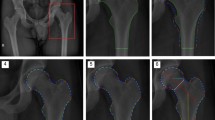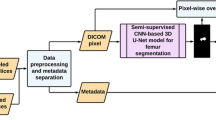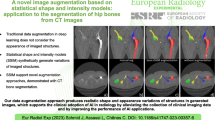Abstract
In many clinical applications, 3D reconstruction of patient-specific structures is of major interest. Despite great effort put in 2D-3D reconstruction, gold standard bone reconstruction obtained by segmentation on CT images is still mostly used – at the expense of exposing patients to significant ionizing radiation and increased health costs. State-of-the-art 2D-3D reconstruction methods are based on non-rigid registration of digitally reconstructed radiographs (DRR) – aiming at full automation – but with varying accuracy often exceeding clinical requirements. Conversely, contour-based approaches can lead to accurate results but strongly depend on the quality of extracted contours and have been left aside in recent years. In this study, we revisit a patient-specific 2D-3D reconstruction method for the proximal femur based on contours, image cues, and knowledge-based deformable models. 3D statistical shape models were built using 199 CT scans from THA patients that were used to generate pairs of high fidelity DRRs. Convolutional neural networks were trained using the DRRs to investigate automatic contouring. Experiments were conducted on the DRRs, and calibrated radiographs of a pelvis phantom and volunteers – with an analysis of the quality of contouring and its automatization. Using manual contours and DRR, the best reconstruction error was 1.02 mm. With state-of-the-art results for 2D-3D reconstruction of the proximal femur, we highlighted the relevance and challenges of using contour-driven reconstruction to yield patient-specific models.
Access this chapter
Tax calculation will be finalised at checkout
Purchases are for personal use only
Similar content being viewed by others
Notes
- 1.
Calibration parameters include e.g., source-detector distance, pixel size, central point, relative transformations between multiple images, etc.
References
Sarkalkan, N., Weinans, H., Zadpoor, A.A.: Statistical shape and appearance models of bones. Bone 60, 129–140 (2014). https://doi.org/10.1016/j.bone.2013.12.006
Gamage, P., Xie, S.Q., Delmas, P., Xu, W.L.: Diagnostic radiograph based 3D bone reconstruction framework: application to the femur. Comput. Med. Imaging Graph. 35(6), 427–437 (2011). https://doi.org/10.1016/j.compmedimag.2010.09.008
Galibarov, P.E., Prendergast, P.J., Lennon, A.B.: A method to reconstruct patient-specific proximal femur surface models from planar pre-operative radiographs. Med. Eng. Phys. 32(10), 1180–1188 (2010). https://doi.org/10.1016/j.medengphy.2010.08.009
Markelj, P., Tomaževič, D., Likar, B., Pernuš, F.: A review of 3D/2D registration methods for image-guided interventions. Med. Image Anal. 16(3), 642–661 (2012). https://doi.org/10.1016/j.media.2010.03.005
Reyneke, C.J.F., Lüthi, M., Burdin, V., Douglas, T.S., Vetter, T., Mutsvangwa, T.E.M.: Review of 2-D/3-D reconstruction using statistical shape and intensity models and X-ray image synthesis: toward a unified framework. IEEE Rev. Biomed. Eng. 12, 269–286 (2019). https://doi.org/10.1109/RBME.2018.2876450
Karade, V., Ravi, B.: 3D femur model reconstruction from biplane X-ray images: a novel method based on Laplacian surface deformation. Int. J. Comput. Assist. Radiol. Surg. 10(4), 473–485 (2014). https://doi.org/10.1007/s11548-014-1097-6
Zheng, G., Yu, W.: Chapter 12 - Statistical shape and deformation models based 2D–3D reconstruction. In: Zheng, G., Li, S., Székely, G. (eds.) Statistical Shape and Deformation Analysis, pp. 329–349. Academic Press (2017)
Klima, O., Kleparnik, P., Spanel, M., Zemcik, P.: Intensity-based femoral atlas 2D/3D registration using Levenberg-Marquardt optimization. In: Medical Imaging 2016: Biomedical Applications in Molecular Structural, and Functional Imaging, vol. 9788, p. 97880F (2016)https://doi.org/10.1117/12.2216529
Yu, W., Chu, C., Tannast, M., Zheng, G.: Fully automatic reconstruction of personalized 3D volumes of the proximal femur from 2D X-ray images. Int. J. Comput. Assist. Radiol. Surg. 11(9), 1673–1685 (2016). https://doi.org/10.1007/s11548-016-1400-9
Baka, N., et al.: 2D–3D shape reconstruction of the distal femur from stereo X-ray imaging using statistical shape models. Med. Image Anal. 15(6), 840–850 (2011). https://doi.org/10.1016/j.media.2011.04.001
Zheng, G.: Personalized X-Ray reconstruction of the proximal femur via intensity-based non-rigid 2D-3D registration. In: Fichtinger, G., Martel, A., Peters, T. (eds.) MICCAI 2011. LNCS, vol. 6892, pp. 598–606. Springer, Heidelberg (2011). https://doi.org/10.1007/978-3-642-23629-7_73
Boussaid, H., Kadoury, S., Kokkinos, I., Lazennec, J.-Y., Zheng, G., Paragios, N.: 3D model-based reconstruction of the proximal femur from low-dose Biplanar X-Ray images. In: The 22nd British Machine Vision Conference - BMVC 2011, Dundee, United Kingdom, pp. 1–10, August 2011. https://doi.org/10.5244/C.25.35
Cerveri, P., Sacco, C., Olgiati, G., Manzotti, A., Baroni, G.: 2D/3D reconstruction of the distal femur using statistical shape models addressing personalized surgical instruments in knee arthroplasty: A feasibility analysis. Int. J. Med. Robot. Comput. Assisted Surgery 13(4), e1823 (2017). https://doi.org/10.1002/rcs.1823
Youn, K., Park, M.S., Lee, J.: Iterative approach for 3D reconstruction of the femur from un-calibrated 2D radiographic images. Med. Eng. Phys. 50, 89–95 (2017). https://doi.org/10.1016/j.medengphy.2017.08.016
Wu, J., Mahfouz, M.R.: Reconstruction of knee anatomy from single-plane fluoroscopic x-ray based on a nonlinear statistical shape model. JMI 8(1), 016001 (2021). https://doi.org/10.1117/1.JMI.8.1.016001
Mahfouz, M.R., Hoff, W.A., Komistek, R.D., Dennis, D.A.: Effect of segmentation errors on 3D-to-2D registration of implant models in X-ray images. J. Biomech. 38(2), 229–239 (2005). https://doi.org/10.1016/j.jbiomech.2004.02.025
Grupp, R.B., et al.: Automatic annotation of hip anatomy in fluoroscopy for robust and efficient 2D/3D registration. Int. J. Comput. Assist. Radiol. Surg. 15(5), 759–769 (2020). https://doi.org/10.1007/s11548-020-02162-7
Kasten, Y., Doktofsky, D., Kovler, I.: End-To-end convolutional neural network for 3D reconstruction of knee bones from bi-planar X-ray images. In: Deeba, F., Johnson, P., Würfl, T., Ye, J.C. (eds.) MLMIR 2020. LNCS, vol. 12450, pp. 123–133. Springer, Cham (2020). https://doi.org/10.1007/978-3-030-61598-7_12
Livyatan, H., Yaniv, Z., Joskowicz, L.: Gradient-based 2-D/3-D rigid registration of fluoroscopic X-ray to CT. IEEE Trans. Med. Imaging 22(11), 1395–1406 (2003). https://doi.org/10.1109/TMI.2003.819288
Damopoulos, D., et al.: Segmentation of the proximal femur in radial MR scans using a random forest classifier and deformable model registration. Int. J. Comput. Assist. Radiol. Surg. 14(3), 545–561 (2019). https://doi.org/10.1007/s11548-018-1899-z
Zhou, Z., Siddiquee, M.M.R., Tajbakhsh, N., Liang, J.: UNet++: redesigning skip connections to exploit multiscale features in image segmentation. IEEE Trans. Med. Imaging 39(6), 1856–1867 (2020). https://doi.org/10.1109/TMI.2019.2959609
Radosavovic, I., Kosaraju, R.P., Girshick, R., He, K., Dollar, P.: Designing network design spaces. In: 2020 IEEE/CVF Conference on Computer Vision and Pattern Recognition (CVPR), Seattle, WA, USA, pp. 10425–10433, June. 2020. https://doi.org/10.1109/CVPR42600.2020.01044
Benameur, S., Mignotte, M., Parent, S., Labelle, H., Skalli, W., de Guise, J.: 3D/2D registration and segmentation of scoliotic vertebrae using statistical models. Comput. Med. Imaging Graph. 27(5), 321–337 (2003). https://doi.org/10.1016/S0895-6111(03)00019-3
Unberath, M., et al.: DeepDRR – a catalyst for machine learning in fluoroscopy-guided procedures. In: Frangi, A.F., Schnabel, J.A., Davatzikos, C., Alberola-López, C., Fichtinger, G. (eds.) MICCAI 2018. LNCS, vol. 11073, pp. 98–106. Springer, Cham (2018). https://doi.org/10.1007/978-3-030-00937-3_12
Hataya, R., Zdenek, J., Yoshizoe, K., Nakayama, H.: Faster AutoAugment: learning augmentation strategies using Backpropagation. In: Vedaldi, A., Bischof, H., Brox, T., Frahm, J.-M. (eds.) ECCV 2020. LNCS, vol. 12370, pp. 1–16. Springer, Cham (2020). https://doi.org/10.1007/978-3-030-58595-2_1
Kurazume, R., et al.: 3D reconstruction of a femoral shape using a parametric model and two 2D fluoroscopic images. Comput. Vis. Image Underst. 113(2), 202–211 (2009). https://doi.org/10.1016/j.cviu.2008.08.012
Acknowledgement
This work was supported by the Swiss CTI project MyPlanner (no. 25258.1). Authors would like to thank E. Ambrosetti, A. Al-Musibli, L. Assassi and B. Lokaj at the Geneva School of Health Sciences and M. Bernardoni, M. Parravicini and D. Ascani at Medacta International SA.
Author information
Authors and Affiliations
Corresponding author
Editor information
Editors and Affiliations
Rights and permissions
Copyright information
© 2021 Springer Nature Switzerland AG
About this paper
Cite this paper
Chênes, C., Schmid, J. (2021). Revisiting Contour-Driven and Knowledge-Based Deformable Models: Application to 2D-3D Proximal Femur Reconstruction from X-ray Images. In: de Bruijne, M., et al. Medical Image Computing and Computer Assisted Intervention – MICCAI 2021. MICCAI 2021. Lecture Notes in Computer Science(), vol 12906. Springer, Cham. https://doi.org/10.1007/978-3-030-87231-1_44
Download citation
DOI: https://doi.org/10.1007/978-3-030-87231-1_44
Published:
Publisher Name: Springer, Cham
Print ISBN: 978-3-030-87230-4
Online ISBN: 978-3-030-87231-1
eBook Packages: Computer ScienceComputer Science (R0)





